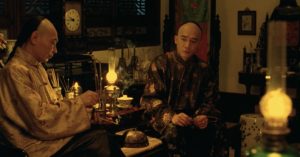Shanghai
28 The Identity of a City: Flowers of Shanghai (1998) by Zahra Gokal
Zahra Gokal
Flowers of Shanghai (1998)

Flowers of Shanghai (1998) directed by Hou Hsiao-Hsien is a beautiful, dream-like movie set in 19th century opium-riddled Shanghai. In the movie, women in a brothel house (known as a “Flower House”) go through many challenges involving each other and their patrons. The film is described to be seductive, hazy, and disorienting, according to a number of reviews on rottentomatoes.com. Throughout this vibrantly-colored movie, the viewer watches all that happens through the lens of an onlooker from afar, observing silently. The director’s goal is not to take the viewer on a plot-driven journey; rather, he emphasizes how a certain scene feels. The slow, hazy feel of the movie could be compared to how opium itself feels: euphoric, relaxed, and addictive. Hou Hsiao-Hsien incorporates many aspects of Shanghai into the movie, packing in its rich history and culture into many long but intriguing scenes.
Shanghai and Opium
Earlier, it was mentioned that the movie was hazy and had a slow nature to it; this is because opium was prevalent in the film. Every character smoked opium, a highly addictive drug that puts the user in a euphoric state of mind with a slower heart rate. Most of the movie is shadowed by opium smoking, with hookahs being in every room and in nearly every scene. This is significant in the way that it subtly but effectively gives the viewer a sense of what Shanghai was going through at the time.
The Opium Wars took place in China from 1839 to 1860. Opium was initially illegal in China due to its highly addictive nature, but the British wanted to import the good to China regardless. Many foreign traders were illegally importing opium into China, with the Chinese government close on their tail. After many events leading to rising tensions, war was declared by the British and lasted from 1839 to 1942, ending with the Treaty of Nanjing. Of the terms of the treaty, China was required to pay Britain a sum of money as well as allow Britain to own Hong Kong Island. China also had to open more ports around the country to allow more trading to occur. Shanghai was one of the ports, which was one of the main catalysts in allowing it to transform into a significant economic hub.
The second Opium War was initiated by several more skirmishes and incidents between the Chinese and British. This time, the French joined Britain’s ranks as well. This war lasted from 1856 to 1860 and resulted in the legalization of opium importation by negotiations in Shanghai. In addition to this, according to the treaties of Tianjin decided in 1858, China was required to provide residence to foreign representatives in Beijing and open more ports to Western trade among other settlements. In 1860, the Chinese government signed the Beijing Convention, ceding part of the Kowloon Peninsula to Britain.
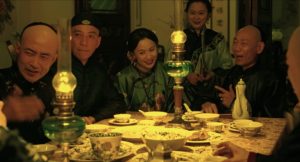
Fast forward to the events of Flowers of Shanghai: the characters are seated around a table, lounging in individual rooms, and conversing with each other all with opium smoke surrounding them. It has been over 20 years since the importation of opium was legalized in China, so naturally, it became engrained into their society, used as devices for leisure and poison. As mentioned earlier on in this essay, the slow scenes represent the slowness of one’s body and state of mind while intoxicated with the effects of opium. The vibrant colors blurred in with the beauty of the surroundings coincide with the calm high that comes along with the drug. After ingesting it, problems seem miniscule. One’s pain seems to disappear. The women in the film experience pain and hardship, but it feels fleeting to the viewer watching from afar. It washes away with the beauty and quietness of the voices, music, and warm hues. The movie itself may as well be an overarching metaphor for opium itself, if not the identity of Shanghai as a whole.

Symbolism
There are little details around the limited space there is within the setting of the flower house that have some sort of symbolism. As the surroundings are shown to the viewer, many things pop out at once: a hookah, pieces of pottery, and paintings on the walls. These are small reminders of a greater society outside the flower house: China — more specifically, Shanghai — in the 1880s. Many of these items were granted and paid for by customers of the flower girls, for the flower girls.
The colors of the movie are clear: warm colors which include reds, oranges, and yellows. Very rarely is there a different color as the main color of the movie. Red is one of the main colors in Chinese culture, and is typically worn during weddings. Traditionally, red is the color of love, passion, and anger. These are all themes in the flower houses. Patrons pay the girls for sex and company, which comes with intense passion and longing. Events of the movie prove that attraction and attachment also comes with being with one another for long: Master Wang had been calling for Crimson for a couple of years, and the two of them developed feelings for each other that turned sour as the movie progressed. Wang fell for Jasmin after Crimson refused to marry him, which angered Crimson. Wang promised to compensate her for it by paying her debts, but as he still had feelings for her, he broke all her possessions in a rage after finding out she may have slept with someone else. Wang eventually married Jasmin, who cheated on him with his nephew.
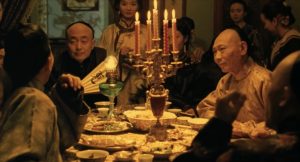
Orange and yellow are shown a great deal in the movie as well. Both colors represent happiness and wealth, two qualities that one can use to describe the patrons in the brothel house. Many scenes show the wealthy men talking and playing drinking games over a table in a dining room, surrounded by their regular flower girls and the servants in the house. If they are regulars, it would mean they have enough money to continue going for years on end. Many decorations, pottery, and furniture in the houses were granted and paid for by these patrons of the flower girls, for the flower girls.
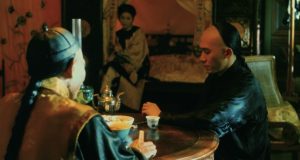
Social Customs and Hierarchies
The regular patrons in the flower houses are clearly upper-class citizens within the realm of business and social life. Master Wang himself was said to have a promotion and move from Shanghai to Guangdong with Jasmin toward the end of the movie.
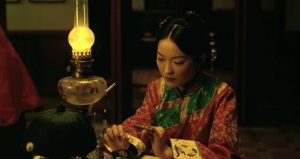
Despite being surrounded by the luxuries brought to them by their customers, however, the flower girls live a life of slavery. They are bought as young girls and are brought up and trained by their flower house “aunty,” and when they come of age, they start working. Their source of income depends on how they perform for the men who come in for them. If they behave and can sell themselves well, the man who comes to see them may decide to buy them something they want. A good amount of the money the flower girls earn goes to their aunty regardless of how much they make. They are exploited, sexualized, and abused in this industry they never asked to work for. They can only hope to get married to one of their patrons before they grow older and the valued beauty of their youth expires.

These girls, unfortunately, are seen as objects in the grand scheme of the movie. Even their names are those of valued objects: Jade, Emerald, Crimson, Pearl, and Jasmin. Even then, each of the girls have distinct goals and desires that are seen in the movie.
Jade wants to marry one of her patrons, Master Zhu. While together, they make promises to each other to be married and be together forever — and die together. Jade takes this to the next level as she decides for the two of them to drink raw opium and die in the room together, but Master Zhu calls for help and they are saved as the other girls in the house feed them the antidote. The situation is solved as Master Zhu agrees to sponsor her so she could be freed and get married to someone else who comes along.
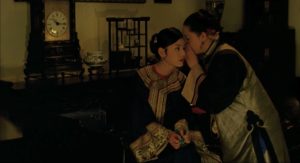
Emerald wants to be free. Her aunty tells her that she bought Emerald for $100 as a child, and her worth has risen significantly over the years — around $3,000. During various moments of the film, Emerald tries to negotiate this price with the aunty and manages to get the sponsorship of her patrons to finally free herself from the flower house.
Crimson’s and Jasmin’s story were told earlier and Pearl did not have a main role in the film, but each one of them had their own grievances. At the end of the day, these girls were victims. They were betrayed by society and even by their own aunties, driven to turn against each other and do whatever they can to rise to the top in a battle to survive.
Shanghai’s identity runs through their blood. The blur of the flower house and their melancholic souls are what shapes them, but they did not let any of their hardships break down who they are. They still have passion, beauty, and youth in their hearts over the tough years, just as the city of Shanghai does after being broken and humiliated. Through Hou Hsiao-Hsien, Shanghai lives in the flower girls, the flower house, and the elements of Flowers of Shanghai. Despite it all, it lives on.
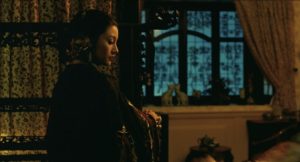
Works Cited
“Living in the Chinese Cosmos: Understanding Religion in Late-Imperial China.” Columbia.edu, 2019, afe.easia.columbia.edu/cosmos/bgov/19th.htm.
“Key Points | Asia for Educators | Columbia University.” Afe.easia.columbia.edu, afe.easia.columbia.edu/main_pop/kpct/kp_1750-1919.htm.
““Flowers of Shanghai” ~Another Film Essay~ | Wellesley Student Blog.” Blogs.wellesley.edu, blogs.wellesley.edu/admission/echen/flowers-of-shanghai-another-film-essay/. Accessed 1 Dec. 2022.
Alcohol and Drug Foundation. “Opium – Alcohol and Drug Foundation.” Adf.org.au, 10 Nov. 2021, adf.org.au/drug-facts/opium/.
Hou, Hsiao-Hsien, et al. “Hai Shang Hua.” IMDb, 17 Oct. 1998, www.imdb.com/title/tt0156587/. Accessed 3 Dec. 2022.
“Flowers of Shanghai.” Www.rottentomatoes.com, www.rottentomatoes.com/m/flowers_of_shanghai. Accessed 29 Nov. 2022.
Ma, Jean. “Flowers of Shanghai: Inside the Dream.” The Criterion Collection, www.criterion.com/current/posts/7395-flowers-of-shanghai-inside-the-dream. Accessed 25 Nov. 2022.
Hou Hsiao-hsien. “Flowers of Shanghai (1998).” Internet Archive, 1998, archive.org/details/989pa.com-.-flowers.of.-shanghai.-1998.-bd-1080-p.-x-264.-aac.. Accessed 1 Dec. 2022.
Pletcher, Kenneth. “Opium Wars | Definition, Summary, Facts, & Causes.” Encyclopædia Britannica, 2 Nov. 2018, www.britannica.com/topic/Opium-Wars.
“Flowers of Shanghai.” Wikipedia, 16 Sept. 2022, en.wikipedia.org/wiki/Flowers_of_Shanghai. Accessed 1 Dec. 2022.
Media Attributions
- flowers image
- IMG_4799
- IMG_4792
- flowersshanghai-590×308
- IMG_4783
- IMG_4779
- IMG_4794
- IMG_4775
- IMG_4784
- IMG_4789

